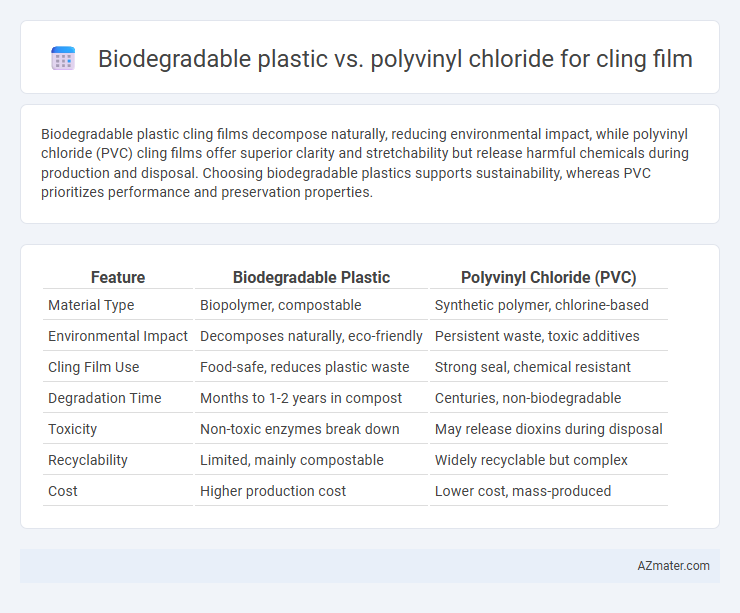Biodegradable plastic cling films decompose naturally, reducing environmental impact, while polyvinyl chloride (PVC) cling films offer superior clarity and stretchability but release harmful chemicals during production and disposal. Choosing biodegradable plastics supports sustainability, whereas PVC prioritizes performance and preservation properties.
Table of Comparison
| Feature | Biodegradable Plastic | Polyvinyl Chloride (PVC) |
|---|---|---|
| Material Type | Biopolymer, compostable | Synthetic polymer, chlorine-based |
| Environmental Impact | Decomposes naturally, eco-friendly | Persistent waste, toxic additives |
| Cling Film Use | Food-safe, reduces plastic waste | Strong seal, chemical resistant |
| Degradation Time | Months to 1-2 years in compost | Centuries, non-biodegradable |
| Toxicity | Non-toxic enzymes break down | May release dioxins during disposal |
| Recyclability | Limited, mainly compostable | Widely recyclable but complex |
| Cost | Higher production cost | Lower cost, mass-produced |
Introduction to Cling Film Materials
Cling film materials primarily include biodegradable plastics and polyvinyl chloride (PVC), each offering distinct environmental and functional properties. Biodegradable plastics are derived from renewable resources and decompose more rapidly, reducing long-term ecological impact. In contrast, PVC provides superior clarity and stretchability but poses environmental concerns due to its non-biodegradable nature and potential release of toxic chemicals during degradation.
What is Biodegradable Plastic?
Biodegradable plastic for cling film is made from natural materials such as cornstarch or sugarcane, designed to break down through microbial activity into water, carbon dioxide, and biomass within a short period under composting conditions. This contrasts with polyvinyl chloride (PVC), a synthetic plastic derived from fossil fuels, which can persist in the environment for hundreds of years due to its resistance to biodegradation. The environmental impact of biodegradable plastics is lower, offering reduced plastic waste accumulation and decreased reliance on non-renewable resources in cling film applications.
Overview of Polyvinyl Chloride (PVC)
Polyvinyl chloride (PVC) is a widely used synthetic plastic polymer known for its durability, flexibility, and excellent barrier properties, making it a popular choice for cling film applications. PVC cling film offers strong resistance to moisture, oxygen, and fat, effectively preserving food freshness and extending shelf life. However, PVC is non-biodegradable and raises environmental concerns due to its persistence and potential release of harmful additives during disposal.
Environmental Impact: Biodegradable Plastic vs PVC
Biodegradable plastic cling films decompose naturally within months, significantly reducing long-term environmental pollution compared to polyvinyl chloride (PVC), which can persist in landfills for centuries. PVC production and disposal release harmful dioxins and chlorine-based compounds, contributing to soil and water contamination. In contrast, biodegradable plastics minimize toxic emissions and support sustainable waste management by breaking down into non-toxic byproducts.
Food Safety and Health Considerations
Biodegradable plastics used for cling film offer enhanced food safety by minimizing chemical leaching and reducing exposure to toxic additives compared to polyvinyl chloride (PVC), which may release harmful phthalates and plasticizers during contact with fatty foods. Biodegradable cling films decomposed by microorganisms pose less environmental and health risk, aligning with stricter food safety regulations and consumer demand for non-toxic packaging. PVC cling film's potential to transfer carcinogenic compounds raises concerns over long-term health impacts, making biodegradable alternatives a safer choice for food storage.
Performance and Durability Comparison
Biodegradable plastic cling films offer moderate durability with effective sealing properties suitable for short-term food storage, while polyvinyl chloride (PVC) cling films provide superior performance in stretchability, clarity, and moisture barrier strength, ensuring longer-lasting protection. PVC films maintain their integrity under varied temperature conditions better than most biodegradable alternatives, which may degrade or lose strength when exposed to heat or moisture. Despite environmental advantages, biodegradable films often sacrifice the mechanical resilience and cling performance that make PVC the preferred choice in commercial and household applications.
Cost Analysis and Market Availability
Biodegradable plastic cling films generally have higher production costs due to raw material prices and complex manufacturing processes compared to polyvinyl chloride (PVC), which benefits from established, cost-effective production infrastructure. Market availability of PVC cling films is widespread and consistent, supported by long-standing supply chains and extensive industrial adoption, whereas biodegradable options face limited availability primarily in niche markets and require further scaling to achieve competitive pricing. Cost analysis highlights that despite higher upfront costs, biodegradable films may benefit from growing regulatory support and consumer demand driving potential economies of scale over time.
Recycling and End-of-Life Options
Biodegradable plastic cling films offer improved compostability and reduced environmental impact compared to polyvinyl chloride (PVC), which poses significant challenges in recycling due to its chlorine content and potential release of toxic substances. PVC cling films often end up in landfills or incinerators, where they can emit harmful dioxins, whereas biodegradable alternatives can be industrially composted or, in some cases, home composted, facilitating more sustainable end-of-life management. Recycling streams for biodegradable plastics remain limited, but their ability to degrade naturally under proper conditions distinguishes them from PVC's persistent environmental footprint.
Regulatory Standards and Certifications
Biodegradable plastic cling films often comply with international standards such as ASTM D6400 and EN 13432, certifying their compostability and environmental safety. Polyvinyl chloride (PVC) cling films must adhere to stringent food contact regulations like the FDA 21 CFR 177.2600 and EU Regulation No 10/2011 to ensure consumer safety and limit harmful plasticizer migration. Both materials require compliance with specific labeling and recycling codes, influencing their acceptance across global markets.
Future Trends in Cling Film Technologies
Biodegradable plastics in cling film production are gaining traction due to increasing environmental regulations and consumer demand for sustainable packaging solutions, offering reduced carbon footprints and enhanced compostability compared to traditional polyvinyl chloride (PVC). Innovations in bio-based polymers and enzymatic degradation methods are accelerating the shift toward eco-friendly cling films with improved barrier properties and mechanical strength. Emerging trends include the integration of nanomaterials and multilayer biodegradable composites to achieve comparable performance to PVC while ensuring full environmental compatibility.

Infographic: Biodegradable plastic vs Polyvinyl chloride for Cling film
 azmater.com
azmater.com